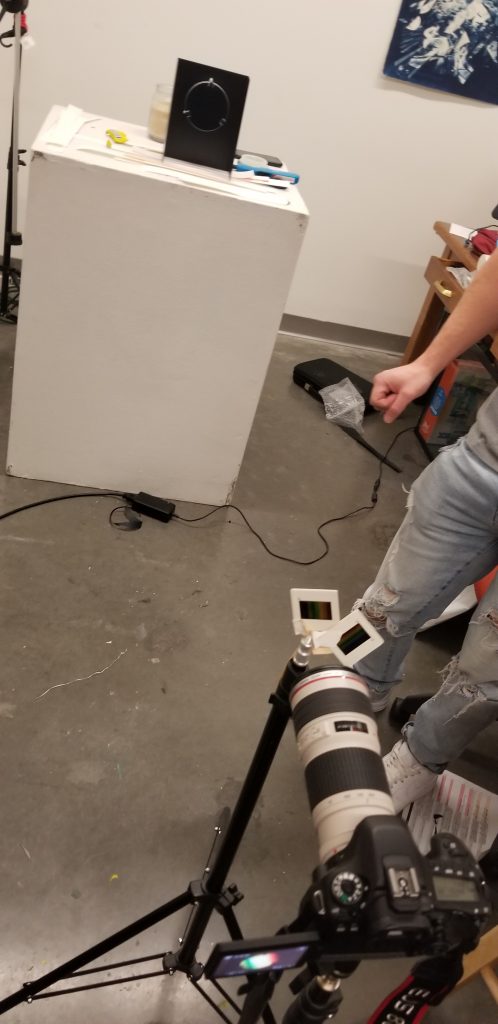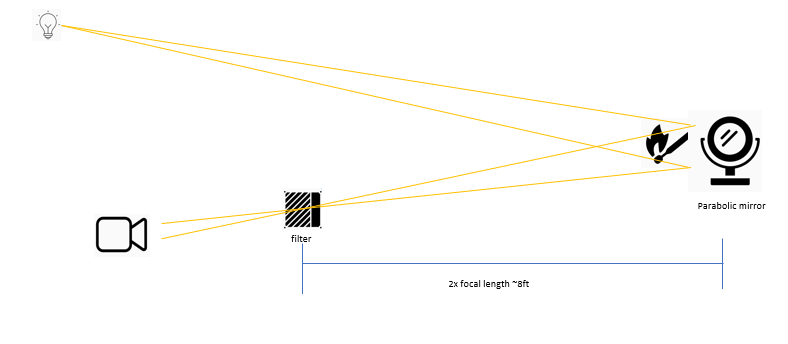Cannon EOS 80D with EF 70-200mm lens – ISO 1000, F/4.5, 1/160 sec
Film: Alejandra Abad, Lights: Dimario Cancanon
The Duel by Benjamin Tissot (https://www.bensound.com/royalty-free-music/track/the-duel)
Schlieren Flow Visualization
Jamie Frankel
Assistance from: Dimario Cancanon and Alejandra Abad
12/14/19
The reason for this video was to challenge ourselves to do more and more complex visualization of flow. We aimed and succeeded with capturing the pressure difference around a flame using simplified schlieren photography.
The apparatus used included a parabolic mirror, a small 13-watt head lamp on a tripod, and a large Canon EOS 80 D camera on a tripod with colored filters in front of it. The light was placed behind the camera with the mirror in front on a stand fine-tuned using slips of paper underneath. The light and the mirror were situated such that the light bounced from the mirror directly into the lens of the camera and it was the only part illuminated in the dark room (Figures 1 and 2). There were small squares of colored film (filters) placed in front of the camera in order to help the phenomenon be more distinguishable on camera. The mirror had a focal length of 4ft so the camera was about 8ft away from the mirror. I held the lighter in front of the mirror while Dimario worked the lights and Alejandra maned the filters and used a filter as a knife edge to deflect light rays.


Schlieren visualization is possible because light bends when it interacts with changes in density, temperature, or pressure of the air in front of the parabolic mirror. In this case the lighter caused pockets of hot air to rise around the flame and therefore be less dense. When light passes through higher density air it refracts to one side of the focal point while light passing through less dense air bounces to the other side of the focal point. The knifepoint, or in this case the edge of the filter (which is placed at the focal point), blocks the half of the light that passed through the less dense air without distorting the image (Rolfe, n.d.). The change in the refractive index deflects the image of the light and if it is deflected past the edge of the filter it will appear to the camera as a streak of light, because the light isn’t binary different shades of gray appear and correspond to the different densities. According to Harvard’s Natural Sciences Lecture Demonstrations the brightness of the effect is proportional to the magnitude of change in refraction, so the larger the fluctuation of the density of the air the larger the diffraction of light and therefore the more amount of light that passes the edge of the knife point and the brighter the image. (Harvard University, n.d.). Based on estimations from Schlieren and Shadowgraph Techniques I would estimate a maximum ray deflection angle on the same order of magnitude as 0.06 degree (Settles, 2001).
The video was taken with a Canon EOS 80 D. The focal length of the lens was 70- 200mm. The field of view was about 6 inches in diameter. The F-stop was set to f/4.5, exposure was 1/160 seconds, ISO was set at 1000, and the video was taken without a flash. The video was edited in Wondershare Filmora9 to remove any footage without schlieren effects present. The video is 1920 x1080 pixels.
I really like my video and that in a very simple way it is able to capture a typically invisible phenomenon. I paired it with obscure intense song to give a perception of importance. I wish that we would have brought more things to show with schlieren. I also think in the future I would use different color filters and a larger mirror.
Bibliography
Harvard University. (n.d.). Schlieren Optics. Retrieved from Harvard Natural Sciences Lecture Demonstrations: https://sciencedemonstrations.fas.harvard.edu/presentations/schlieren-optics</p>
Rolfe, B. (n.d.). Schlierren Imaging: How to See Air Flow! Retrieved from Instructables Workshop : https://www.instructables.com/id/Schlieren-Imaging-How-to-see-air-flow/
Settles, G. S. (2001). Schlieren and Shadowgraph Techniques: Visualizing Phenomena in Transparent Media. Springer-Verlag Berlin Heidelberg.

3 Comments. Leave new
I liked the music! Super cool.
It’s really cool! What are the colors in the background caused by?
I liked the dramatic feel of the music.